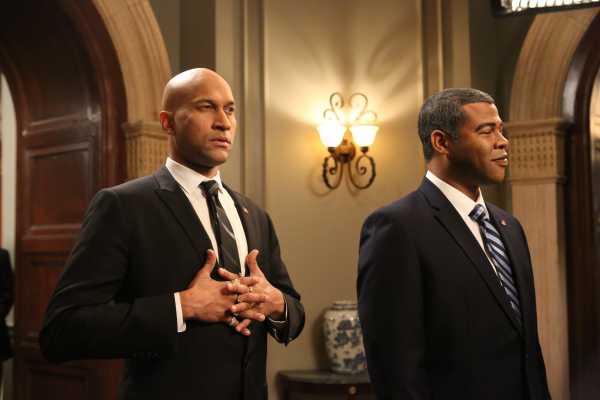
Two years after Jordan Peele’s buzzy and groundbreaking film debut electrified pop culture, Get Out remains not only one of the most important films of 2017 but also one of the most significant films in recent memory. It’s a canny, vastly entertaining horror movie, deeply rooted in well-established tropes of the genre but equally rooted in the experience of being black in America. Get Out was the rare crowd-pleaser that enjoyed tremendous critical acclaim, a viral meme factory that also received an Oscar nomination for Best Picture and yielded Peele the Academy Award for Best Original Screenplay.
So it’s hardly a surprise that Peele’s follow-up film, Us, has had one of the buzziest openings of 2019 so far. The highly anticipated and critically acclaimed horror movie had advanced ticket sales that surpassed both Get Out and 2018’s sleeper horror hit A Quiet Place, and knocked Captain Marvel off her box office throne with a record-breaking $70 million opening weekend — the highest ever for an original horror film, and second-highest for an action-adventure movie.
Us has cemented Peele’s place within the recent modern era of innovative, original, and allegorically rich horror filmmaking. But that’s not all he’s been up to. In the wake of his Get Out success, he’s also recently executive produced the Amazon Prime documentary Lorena, as well as another upcoming Amazon Prime series, The Hunt. He’s also executive-producing a remake of Candyman, the cult horror movie about gentrification that influenced Get Out. On the acting side, he’s joined the cast of Netflix’s upcoming stop-motion movie Wendell and Wild, and he’s voicing a character in the upcoming Toy Story 4.
The series he co-created for TBS, The Last O.G., is returning for a second season; Peele also co-wrote the recent YouTube Premium sci-fi anthology series Weird City. And on top of directing his sophomore feature, Peele’s also hosting CBS All Access’s highly anticipated upcoming Twilight Zone reboot, a role that taps into his expansive knowledge of horror as a genre and as a medium for exploring our deepest anxieties.
But as all these recent and upcoming projects indicate, Peele doesn’t just do horror — not even close. In fact, he’s even better known as a comedy writer and performer, as one half of the comedy sketch duo Key and Peele, stars of the cult hit Comedy Central show of the same name.
While you might not see any direct connection between his comic beginnings and his current status as a critically acclaimed genre auteur, if we take a closer look, it’s easy to see just how much of an overlap there is between Peele’s past and present work — and just how well Key & Peele prepared him to take his explorations of genre conventions and tropes to the next level.
The nature of Peele’s upbringing primed him to explore themes of persona and performativity in his comedy
Peele, 40, was born in New York City in 1979 and raised on the Upper West Side. Growing up in a biracial family, Peele frequently had to code switch, a fact that played a huge part in his upbringing and made a deep impression on him. “The world has wanted me to speak differently than I speak,” he noted in 2013, in an interview with NPR’s Fresh Air.
“I speak like my mom; I speak like the whitest white dude; I speak like a Def Comedy Jam comedian doing an impression of a white guy … I even remember when I was a kid that every now and then you’d come up on somebody who would question how I spoke and whether or not I was trying to be something I wasn’t.“
This pressure to be a chameleon led to what seems to be Peele’s lifelong fascination with disappearing into other roles and voices. He attended Sarah Lawrence College in Westchester, New York, intending to study puppeteering before being seduced by the call of improv. As Peele made inroads as a comedy performer, he became known for creating intensely embodied performances and uncanny impersonations (most famously his Barack Obama impression). As he told NPR, that was part of the trick.
“It cannot be a coincidence that I decided to go into a career where my whole purpose is altering the way I speak and experiencing these different characters and maybe proving in my soul that the way someone speaks has nothing to do with who they are,” he said.
Peele became known for deftly inhabiting characters in comedy skits, which led to him joining the cast of Fox’s sketch comedy staple Mad TV in 2003 — alongside new performer Keegan Michael Key. In one of those rare moments of serendipity, the two had met not long before joining the show, while performing improv at Chicago’s Second City — where they “fell in comedy love.”
On Mad TV, Key and Peele were breakout stars, whose chemistry together made them one of comedy’s most versatile duos. In addition to honing their partnership at Mad, they also started to hone nuanced and satirical looks at race, and it was this aspect of their comedy, combined with their hilarious takes on pop culture and their diverse range of characters, that would make Key & Peele a hit.
Key & Peele was brilliant comedy. It also contained all the ingredients for Peele’s horror.
Over the course of Key & Peele, which ran for five seasons on Comedy Central between 2012 and 2015, Key and Peele heavily focused on skewering pop culture tropes — everything from friendship ballads to primitive warrior tribes to Saw, The Usual Suspects, and Les Misérables — along with hilariously parodying the excesses of Hollywood itself.
But the duo didn’t just play with tropes in order to merely subvert them. They also frequently utilized them to highlight cultural and social anxieties and quirks — often involving race in America.
Key and Peele were also on-point when it came to hilariously and shrewdly dissecting aspects of racial identity. They frequently mined the act of code-switching for comedy; in one famous sketch, two black men put on fronts full of swagger to appear tougher than they each are; in another, they parody President Barack Obama’s tendency to move between sober formality and more laidback tones, depending on who he’s talking to.
They also frequently took aim at the way racialized ideas can warp perspectives. In one of their most popular sketches, a black substitute teacher extravagantly mispronounces the names of students in his all-white classroom in a hilarious parody of the tendency of white people to exoticize and overreact to the names of people of color. In another sketch that directly presages the tone and general theme of Get Out, the scenario of a black man wearing a hoodie in a white neighborhood is framed as a scene from a horror movie:
A major theme of Key and Peele’s comedy, part of it built into the range and versatility of the characters they play, is a disconnect between a perceived social context and actual experience — which can produce comedy that is as frequently uncomfortable as it is revealing.
This gap between perception and reality is also a huge theme of each of Peele’s horror films to date. Where Get Out took the classic theme of an idyllic suburbia masking dark secrets and applied it to the cultural experience of blackness in America, Us took this concept even further with a richly layered plot that revolved around the idea of secret, terrifying doppelgängers — a great horror image that yielded a complex metaphor about privilege and systemic inequality in America.
Many, many creators have used horror to explore what lurks below the surface of the American conscious. But Peele uses horror to not only explore what lurks below the surface, but to also subtly indict his audience for refusing to see it. In Us, it’s the deliberate societal choice to forget, repress, and refuse to learn from the mistakes of the past that allow subterranean horror to cultivate beneath a societal veneer of stability.
It’s significant that Peele continues to imbue his more serious works for the big screen with the satirical comedy he first cut his teeth on, both to balance the tension and to further sharpen the points he’s making. Get Out and Us are significant for much more than their incisive social commentary and deliberate craft; they’re also truly funny, with a unique, smart sense of humor that only a horror filmmaker with his feet in a lighter world could deploy so well.
The lessons Peele’s learned about honing audience appeal, and how to really draw the audience in with relatable, funny characters and situations, are now paying off at the box office — where, after two record-smashing films in a row, “a Jordan Peele movie” is now unquestionably a brand of its own.
Writing about Peele in 2015, Zadie Smith observed that “he is so convincing in voice and gesture that he makes you see what isn’t really there,” but what may be truest about Peele as a director is that he makes you see, and moreover, confront the truth, of what’s always been there — the horror out there, and the horror within yourself.
Sourse: vox.com






